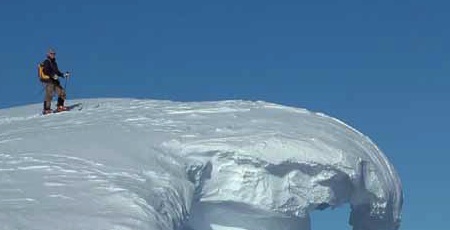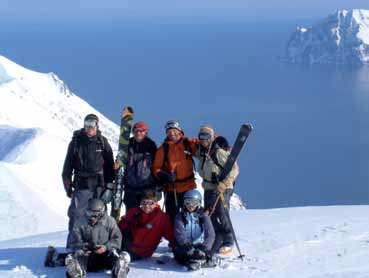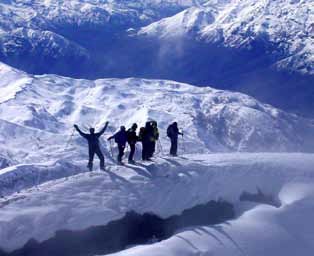Submitted by: Rachael Woolston
Posted: 09/02/2012 Lyngen Alps
Lyngen Alps
Norway
Few people associate boats with heading to the pistes, but that is what you get here as you sail through 60-mile-long Arctic fjords, home to Norway's most impressive mountain range, the Lyngen Alps. While they don't stand as high as their European equivalents (the highest peak, Jiekkevarre, is 1,880m – less than half the height of the Alps' Mont Blanc at 4,810m) they make up for it with the unique opportunity to descend from summit to sea through virgin powder.
Of course, being out in the wilderness means no ski lifts, so every morning starts early with a breakfast of Nordic cheeses, meats and cereals before an ascent of the mountain. It may be hard work, but the reward? Views of snow-capped peaks as far as the eye can see and acres of white powder dropping right down into the sea.
If you're looking for a trip that is just a short flight away, but offers an edge-of-the-world experience, this majestic Polar adventure is it.
Best time to go: February to April
Level: Intermediate/advanced – and fit
Getting there: A bespoke seven-day expedition costs from £11,845 per person based
on two sharing, excluding flights. This includes a guide and local guiding support team, trip
planning, consultation, and all in-country travel, accommodation and meals. Book with Epic
Tomato (www.epictomato.com)
 Kamchatka
Kamchatka
Russia
Fancy skiing a volcano? Kamchatka Peninsula, which lies in the far east of Russia, has 300 of them – 29 of which are active, making for a unique fire and ice experience.
Kamchatka has a landmass the size of Germany, Austria and Switzerland combined, but with a population of around 355,000 it is a world characterised by pure wilderness.
At the ski resort you can expect runs of over 3,000m that feel like they go on forever. They may not be very steep, making them perfect for intermediates and for taking in the spectacular scenery, but there are plenty of hair-raising options that are opened up with heli-skiing.
Get dropped off on the summit and from here a guide will lead you past craters of smoking volcanoes, until you can pick your line and float through the powder, right down to the Pacific Ocean. And if it snows too much for you to get out on the slopes one day, you can always take time out to enjoy the local delicacies –
caviar with a glass of ice cold Russian bubbly or vodka – while relaxing in the natural hot springs.
Come 2014, Russia will also be hosting the Winter Olympics, so you could even combine a trip with some great winter sports viewing.
Best time to go: March to May
Level: Intermediate/advanced
Getting there: Seven nights costs from £4,800 per person based on two sharing, excluding flights. This includes heli-skiing with guides, safety equipment, accommodation and breakfast. Book with Elemental Adventures (www.eaheliskiing.com)
 Alyeska
Alyeska
Alaska
You never need worry about a lack of snowfall here: this North American state has the world's highest average snowfall – around 60ft a year. Add death-defying vertical descents and it's no wonder the ski and board fraternity flock here.
While Alaska is well known for heli-skiing, here at Alyeska, named after the 2,300ft Mount Alyeska under which it nestles, you can access 73 pistes from one of its nine lifts. And that is not to mention all the backcountry – the perfect playground for the advanced skier or boarder. Alyeska is only 40 miles from Anchorage airport, making for short transit times, yet it is still seriously remote, creating an ‘I can't believe
my luck' atmosphere. Plus, you could get lucky and spy the kaleidoscopic Aurora Borealis.
Best time to go: February and March
Level: Intermediate/advanced
Getting there: 10 nights at the Hotel Alyeska costs from £1,865 per person based on two sharing. This includes return flights and transfers from Heathrow. Book with Ski World (www.skiworld.ltd.uk)
 Gulmarg
Gulmarg
Kashmir
Nestled under the majestic Mount Apharwat in the Himalayas, Gulmarg is a mecca for veteran skiiers and boarders. There are acres of deep powder, with some of the biggest ‘dumps' in the world – so you never have to worry about bare patches – and with just 100 visitors a day, making fresh tracks on piste and off is guaranteed.
The scarcity of winter tourists is partly due to Gulmarg's remoteness, but also because it lies near the disputed India/Pakistan border. This means that it's not unusual to spot soldiers sporting AK47s, although no Western tourists have been affected since 1995. Indeed, the Foreign and Commonwealth Office has recently relaxed its guidelines, from advising no travel within the area, to avoiding travel in rural areas. And the luxury hotel chain, the Taj, has recently opened the five-star Dal View in the capital, Srinagar, indicating the country's recovering tourism industry.
In Gulmarg, there are many heavenly descents to choose from, on and off piste. Here the mountain offers four hours of fresh tracks down to picturesque Himalayan villages. And while you may not get an après-ski beer, a delicious Dum-aloo, potato curry and spiced Kahwa tea will more than make up for it.
Best time to go: November and December
Level: Advanced skiiers and boarders
Getting there: Eight nights (six nights in Gulmarg and one each in Srinagar and Delhi)
costs from £1,586 per person based on two sharing. This includes return flights from Heathrow, transfers, accommodation, food and mountain guides. Book with Indus Tours (www.industours.co.uk)
 Arpa
Arpa
Chile
Warm rivers, Chilean red wine and deep, untracked powder: what's not to like? Chile offers challenging terrain for the advanced skier and boarder, and one of its real gems is Ski Arpa, a new resort recently ranked as one of the world's best, which uses snow cats to summit the mountains in the absence of ski lifts. At the top you can see east to South America's highest peak, Cerro Aconcagua, and west to the Pacific Ocean. And down? A 3,000ft vertical drop through deep, fluffy white powder.
Renowned for its volcanoes, the Pacific Rim of Fire, you will get to experience the Chillán Volcano rumbling beneath you before you start your descent down its side. And maybe best of all: their season runs in our summer, offering all-year-round skiing for the truly addicted.
Best time to go: July to early September
Level: Intermediate/advanced
Getting there: Nine days costs from about £2,579 per person based on two sharing, excluding flights. This includes accommodation, meals, wine, guiding and lift passes. Book with Powder Quest (www.powderquest.com)
A risky business
For out-of-this-world snow conditions, you need to take special precautions and get the right insurance.
1. Adventurous destination?
Countries that have experienced political turmoil in the past, such as Kashmir, may have a travel advisory warning issued from the Foreign and Commonwealth Office (FCO). If this is the case, you will need specialist travel insurance, the cost of which will vary according to perceived risks. Check your chosen destination status on www.fco.gov.uk, and ask your travel provider about insurance.
2. Get sufficient cover
Minimise your risk of getting a hefty medical bill, should you get injured, by opting for a high cover limit – ideally more than £5 million. Hospital stays can soon add up, particularly in places like the US and Canada, and standard policies only cover up to £1 million.
3. Going off-piste
Standard policies will not cover heli-skiing or off-piste snow adventures. Once you have found a policy that does cover this, read the small print. Some policies will only cover off-piste in the presence of a qualified guide.
4. Too much snow
Not having enough snow will not be a problem with these destinations, but closures due to avalanche risk could be an issue. Check your policy will cover closures due to too much snow.